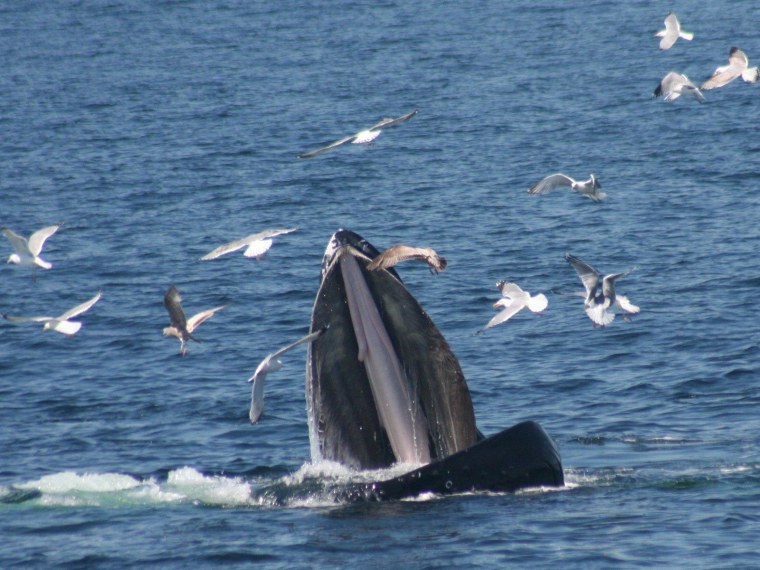Humans aren't the only species swayed by fashion trends and peer pressure. Two newly published studies say vervet monkeys and humpback whales learn eating preferences and feeding techniques from their social groups, too.
Erica van de Waal, a researcher at Scotland's University of St. Andrews, trained four groups of wild vervet monkeys to choose their meals from different colors of dyed corn. In some groups, buckets of blue corn were mixed with a bitter-tasting additive, so the monkeys in that group snacked on the pink kernels. In others, the bitter flavoring was swapped, so monkeys ate only the blue corn.
Here's the big question: Would vervet monkey babies pick up the corn color preference from their mothers? Once new broods of babies started eating solid food, the bucket pairs with color-separated kernels were reintroduced. This time, there was no bitter additive in either bucket. Still, the mums went back to eating the corn they remembered tasted good. Twenty-six of the 27 babies, without trying to experiment, followed suit.
But when the monkeys traveled to other groups, with different eating habits, many picked up the local favorites. Ten wandering males, in search of mates, found themselves in the awkward company of a group that ate a different colored type of corn. Without missing a beat, all but one of them smoothly switched to the local flavor — the very first time they ate from the tub.
The researchers describe the choice as a "When in Rome ..." impulse. It's possible the males switched to the local chow because they didn't want to stick out as newbies, and it might have helped win the favor of the females they'd eventually try to court, the group explained in a paper published in this week's issue of the journal Science.
Frans de Waal, a primatologist at Emory University, said the results of the studies were "striking," particularly because the primate research community had never seen something like the the double-dyed corn study before. "It hints at a level of conformism that most of us had not held possible," he wrote to NBC News in an email, and suggests that "primates are much more cultural creatures than [other] small-scale experiments thus far have indicated."

Off the coast of New England, humpback whales have also shown evidence of social learning.
When stock of their favorite herring crashed, whales in that area switched to gulping down schools of sand lance. Possibly to help gather the fish, they slapped the surface of the water with a tail fluke, and then dove underneath and blew bubbles into the school before lunging to swallow. Scientists who have been watching the whales for 27 years found that the tail-flicking habit has caught on in other whale groups. Whale behavior experts at the University of St. Andrews parsed decades' worth of observational data from 650 humpbacks, and traced the spread of this unique "lobtail" feeding trick through the whale groups.
Jennifer Allen, the first author of the study published in Science, confessed that the dataset is older than she is. "We have a chronological sequence of what each whale is doing and when," she told NBC News. "It's a very complete written picture of what the scientists were looking at at the time."
It isn't clear why lobtail feeding is so popular among humpbacks. Allen said they haven't noticed that lobtail feeders are any healthier or having more babies. They seem to have picked up the trick from each other just because they could. There was only one explanation: "No matter how you slice it, the only model that fit this data well was social learning," she said.
"These kinds of studies give us ideas about the mechanism that are involved in the acquisition of new behavior," Diana Reiss, a professor at Hunter College who studies cognition in dolphins and marine mammals, told NBC News. "They're watching the other humpbacks around them and learning by observing others in their peer group," rather than learning from their mothers, or being genetically wired to feed that way.
Beyond explaining animal behavior, these findings have some implications for how people have traditionally understood human culture.
"Although our behavior is very distinctive, it didn't appear from nowhere — it has some very ancient roots," Andrew Whiten, who led the vervet monkey study, told NBC News. The usual assumption is that "we are the cultural species par excellence on the planet," he said, "but that didn't come out of the blue. We share some of that — that wanting to learn from others — with our primate relatives as well, and larger groups of mammals and maybe birds."
In addition to Whiten and van de Waal, the authors of "Potent Social Learning and Conformity Shape a Wild Primate's Foraging Decisions" include Christele Borgeaud.
In addition to Allen, the authors of "Network-Based Diffusion Analysis Reveals Cultural Transmission of Lobtail Feeding in Humpback Whales" include Mason Weinrich, Will Hoppitt and Luke Rendell.
Nidhi Subbaraman writes about science and technology. Follow her on Twitter and Google+.